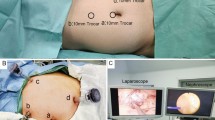Abstract
Purpose
To describe our experience of 33 laparoscopic ureterolithotomies for large ureteral stones.
Methods
Since February 2004, in our department, 33 patients had undergone laparoscopic ureterolithotomy. Inclusion criteria were failure of SWL and\or ureteroscopic treatment. Stones were located in the lower ureter in 9 patients, in the mid ureter in 16 patients, and in the upper ureter in 8 patients.
Results
Mean age of the patients was 47 years (range 37–51). The mean stone size, at preoperative IVP, was 34 mm (range 18–55). All stones were impacted from 4 to 36 months before procedure. Successful rates were 100%. No conversion to open surgery occurred. No intraoperative and postoperative complications occurred. Mean operating time was 85 min (range 60–160). Mean intraoperative blood loss was 70 ml (range 30–120). Mean hospital stay was 3.4 days (range 2–7). Mean follow-up was 24 months (range 6–44). During follow-up, no major complications were observed in any patients.
Conclusions
In our hand, first-line treatment after failure of SWL and\ or ureteroscopy is laparoscopic ureterolithotomy. Large stone size and previous open surgery did not affect the successful rates of laparoscopic ureterolithotomy.

Similar content being viewed by others
References
Wickham JEA (1979) The surgical treatment of renal lithiasis. In: Urinary calculus disease. Churchill Livingstone, New York, pp 145–98
Gaur DD, Agarwal DK, Purohit KC, Darshane AS, Shah BC (1994) Retroperitoneal laparoscopic ureterolithotomy for multiple upper mid ureteral calculi. J Urol 151:1001–1002
Paik ML, Wainstein MA, Spirnak JP, Hampel N, Resnick MI (1998) Current indications of open stone surgery in treatment of renal and ureteric calculi. J Urol 159:374–379
Micali S, Moore RG, Adverch TD, Adams JB, Kavoussi LR (1997) The role of laparoscopy in the treatment of renal and ureteric calculi. J Urol 157:463–466
Bellman GC, Smith AD (1994) Special considerations in the technique of laparoscopic ureterolithotomy. J Urol 151:146–149
Fornara P, Christian D, Mechael S, Dieter J (2000) Why is urologic laparoscopy is minimally invasive? Eur Urol 37:241–250
Vorreuther R (1992) Minimally invasive ureteroscopy using adjustable electrohydraulic lithotripsy. J Endolurol 6:47–50
Hofbauer J, Turek C, Höbarth K, Hasun R, Marberger M (1993) ESWL in situ or ureteroscopy for ureteric stones. World J Urol 11:54–58
Koch J, Balk N (1999) Extracorporeal shock wave lithotripsy of upper ureteral stones: in situ versus push and smash treatment. J Endolurol 5:117–121
Keeley FX, Gialas I, Pillai M, Chrisofos M, Tolley DA (1999) Laparoscopic ureterolithotomy: the Edinburgh experience. BJU Int 84:765–769
Nuyalyong C, Taweemonkongsap T (1999) Laparoscopic ureterolithotomy for upper ureteric calculi. J Med Assoc Thai 82:1028–1033
Lee WC, Hsieh HH (2000) Retroperitoneoscopic ureterolithotomy for impacted ureteral stones. Chang Gung Med J 23:28–32
Basiri A, Simforoosh N, Ziaee A, Shayaninasab H, Moghaddam SM, Zare S (2008) Retrograde, antegrade, and laparoscopic approaches for the management of large, proximal ureteral stones: a randomized clinical trial. J Endourol 22(12):2677–2680
Bove P, Micali S, Miano R, Mirabile G, De Stafani S, Botteri E, Giampaolo B, Vespasiani G (2009) Laparoscopic ureterolithotomy: a comparison between the transperitoneal and the retroperitoneal approach during the learning curve. J Endourol 23(6):953–957
Nouira Y, Kallel Y, Binous MY, Dahmoul H, Horchani A (2004) Laparoscopic retroperitoneal ureterolithotomy initial experience and review of literature. J Endourol 18:557–561
Abolyosr A (2007) Laparoscopic transperitoneal ureterolithotomy for recurrent lower-ureteral stones previously treated with open ureterolithotomy: initial experience in 11 cases. J Endourol 21(5):525–529
Author information
Authors and Affiliations
Corresponding author
Rights and permissions
About this article
Cite this article
Leonardo, C., Simone, G., Rocco, P. et al. Laparoscopic ureterolithotomy: minimally invasive second line treatment. Int Urol Nephrol 43, 651–654 (2011). https://doi.org/10.1007/s11255-010-9872-y
Received:
Accepted:
Published:
Issue Date:
DOI: https://doi.org/10.1007/s11255-010-9872-y




